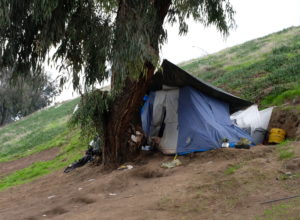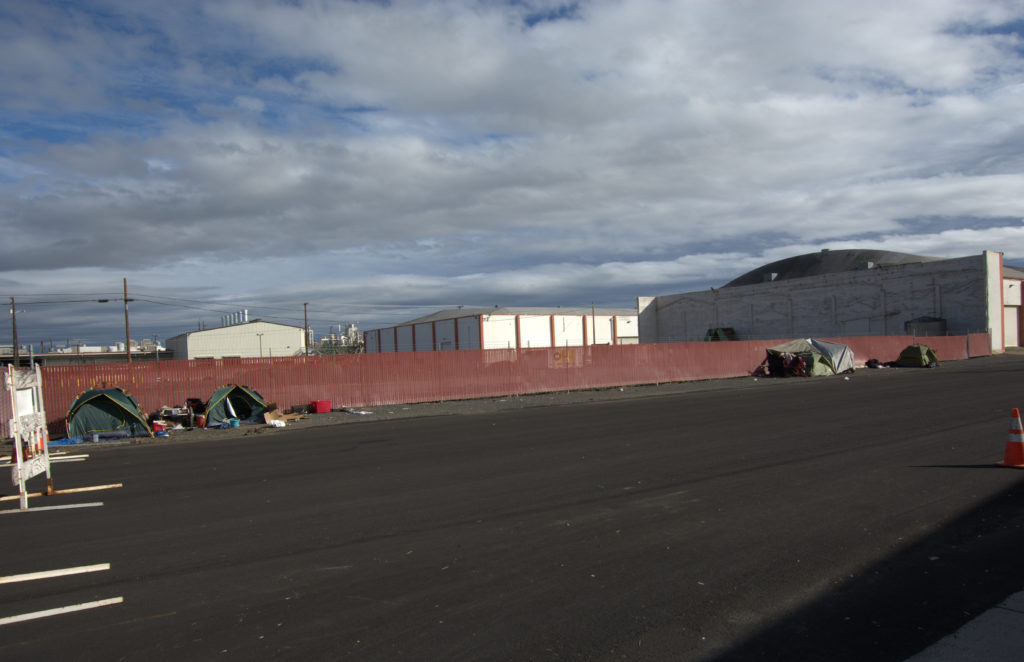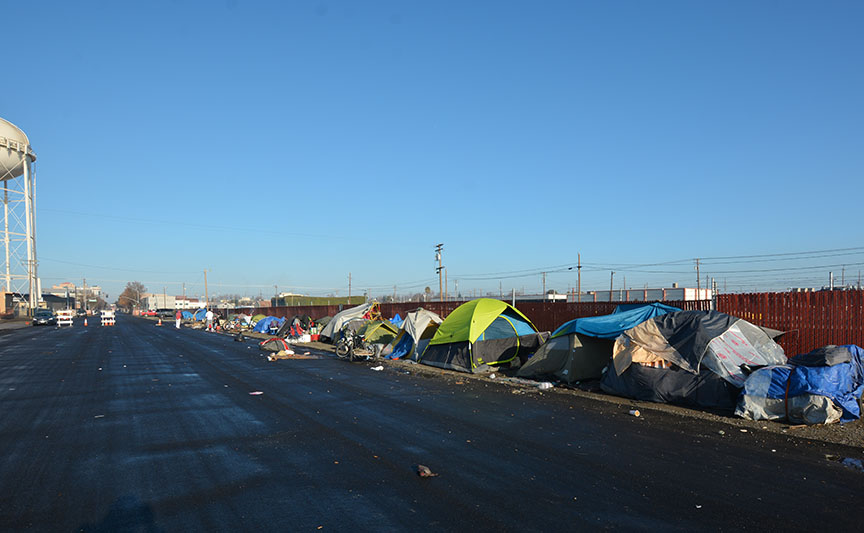Within a few short weeks of establishment of Modesto’s new low-barrier shelter in the Salvation Army Berberian building, tents began appearing along the street opposite the building, mostly occupied by former residents of MOES, the Modesto Outdoor Emergency Shelter. At first there were only a few. Now, the number of tents is growing almost daily, but not as fast as the number of homeless people in our parks, along our rivers, and on our sidewalks.

Governor Gavin Newsom has faced facts and realized there won’t be enough housing or services to stem the rising tide of homelessness for years. He’s authorized use of public lands for temporary housing and offered state money both for transitional temporary living space and more permanent housing and services.
To date, with few exceptions, no one in the state had been willing to admit the obvious truth: We don’t have enough infrastructure and services to address homelessness and it will be years before we do have enough. The failure to face these facts has resulted in wasted time, money, and opportunity.
Most everyone charged with addressing rising homelessness has been operating on the obsolete assumption that shelters—barracks-like buildings featuring heavy rations of rules and religion—can fill the dual needs of rehab and relocation.
According to this traditional model, homeless people just need to, “get back on their feet and get back to work.” It was once a workable approach, but today it ignores just about every current reality that applies to homelessness, most especially the fact we don’t have enough housing for disabled and low income people, including people with fixed incomes—no matter how long they’re in the shelter, they still have nowhere to go.
The shelter model also bypasses entirely the lack of housing and services for homeless people who are mentally ill, estimated at between thirty and forty percent of the total homeless population. At least thirty-three percent are considered seriously mentally ill.
Traditional shelters separate men from women, require people to exit during the day, force residents to listen to sermons before they eat, and deny entry to anyone who’s intoxicated or on drugs. They also don’t allow pets.
The newest concept in shelters—low barrier—allows couples to stay together, permits pets, does not check for drug or alcohol use, and imposes no religious requirements. But even low-barrier shelters, when in the form of a barracks, repel as many homeless people as they attract.

The barracks configuration itself is a barrier to people who fear crowded quarters. It’s also a contagion facilitator, helping spread flu, gastroenteritis, and strep throat, all more common among homeless people than in the greater population.
Nonetheless, shelters in the form of barracks can still serve certain segments of the homeless population until more permanent facilities are built, especially the disabled, elderly, and those needing only temporary assistance. The shelter remains one option for addressing homelessness, but shouldn’t be the only one.
When given a choice, homeless people prefer a tent or tarp to anything else. That’s why we see tent encampments along our rivers, sidewalks, and freeways. The manifold problems of homeless tent camps have been well-documented—they accumulate trash and garbage, attract rats, roaches and bedbugs, and degrade and devalue property values and quality of life.
Inevitably offered as reasons to eradicate homeless camps, few people will acknowledge that poorly managed trailer parks, slums, cheap motels and deteriorated apartment buildings feature the same problems, yet are almost never demonized, mostly because they are less publicized.

When the City of Modesto and Stanislaus County experimented with tent camps at Beard Brook Park and under Modesto’s 9th Street bridge, the results were for the most part positive. The Modesto Outdoor Emergency Shelter (MOES), which was set up early last year, was studied by groups around the state as an effective approach to homelessness.
At its peak, MOES sheltered around 450 people. Quality of life crimes decreased dramatically throughout Modesto, the concentration of people in need made it easier for volunteers to donate food and clothing, and also made it easier for service providers to locate, assess, and serve people in need.
MOES closed when a new shelter became available. Unfortunately, the new shelter could only offer 182 beds and crates for 50 dogs. It couldn’t serve even half the needs of people who had been at MOES.
Since the closure, Modesto’s streets, parks, and sidewalks have seen a surge of homeless people. Authorities are once again caught up in the “move ‘em along” cycle of, “warn ‘em, sweep ‘em, and bust ‘em,” that preceded MOES. And once again, to no one’s surprise, the move ‘em along tactic isn’t working.
Given their experience with Beard Brook Park and MOES, Modesto and Stanislaus County are well-positioned to offer a state model for managed homeless camps. They’ve got a huge reservoir of experience to tap, and most of the personnel who were part of the success of MOES are still available. Authorities should seize the moment and get state funding now for a model approach to homelessness.

Great summary. People and pets need help now. MOES2, perhaps with modifications, could add to the now, while more long term solutions are in the works.
You are totally right about that one for sure and they should have left M.O.E.S and even B.B.V. ALONE AND ADDED MORE PARKS FOR THE HOUSELESS PEOPLE AND THEIR FURBABIES FAMILY’S TO BE THERE ,HELL YEAH 1000% INDEED .AND DEFINITELY GLAD THE GOV .OF CALIFORNIA IS GOING TO DO SOMETHING GREAT FOR ALL OF US WHO ARE HOUSELESS AT LAST , OVERJOYED AND DEFINITELY HAPPY AS HELL ABOUT THIS .OH YEAH 1000% INDEED .
Great story Eric, very accurate in my opinion, and it was predicted that with MOES closing the excess population would have nowhere to go! There is clearly a huge misunderstanding of those who make up the homeless population and their needs, else why would the decision makers keep trying things that have never worked well!!
When it was clearly demonstrated that Beard Brook Village, with almost no support, and then MOES, with some support, were much more effective than leaving folks to wander the streets, parks, and rivers, why weren’t additional MOES established to handle the still unsheltered? It’s hard to understand why no initiative was forthcoming after they were educated in the issue. MOES was even touted around the State as an innovative and cost effective [$13 a day] way to provide temporary accommodations for the people experiencing homelessness.
The most pressing problems in the system of care are the huge shortages of housing units and wrap-around services needed to work on their issues once housed. Additionally, there is a major shortage of Board and Care [Assisted Living] facilities for those with Serious Mental Health issues, thus they continue to wander our streets.
Hopefully the decision makers will jump on what the State is offering which would bring some relief to our underserved homeless population.
With economic factors continuing to force many into poverty and homelessness it will be a long time before this issue is resolved. At least local decision makers are moving in a positive direction with the limited resources at their disposal as witnessed by the new 182 bed shelter, Kansas house, a family motel, etc. Let’s get all we can from the State and keep the momentum going.
The easiest way that Love can apply to all fellow Americans is to adress it in the way that supports all Americans are created equal
Thoughtful & insightful article. Compared to what it was this community has done more to look with unblinking eyes at the homelessness issues begin ago figure out answers. Thank you Modesto👏🏻👏🏻👏🏻
I got 24 years clean an sober in modesto an willing to help
A lot of people believe all the MOES people were moved into shelters and all was good. Anyone who has followed anything about the homeless for years knew it wasn’t. Very good and accurate article. One can only hope it wakes people up to reality.
Has anyone considered tenements being built ? I think money spent on that would be much better than supplying free needles for drug addicts. If we aren’t careful, we will end up like LA or San Francisco
Great article. Anyone who can add and subtract knows you can’t fit 450 people into a facility that hold half that many and of course the homeless complained because they had become a unit that had familiarity and trust. Anyone who tried to bring supplies and assistance to Beard Brook knew that was not planned out. They were on an embankment with no provisions for rain. The City at the very least should have sandbagged the top to keep water out of the tents. I didn’t visit the 9th street facility but pictures showed a much more organized operation. When our organization put together supplies for that location the new management came to the warehouse and hauled it away. Why the tents for overflow cannot be reinstalled there has not been explained adequately. As far as warnings to move along, I thought the reason Cities started looking at this issue at all was a new law that prohibited Cities from citing anyone for being on the street only if there was adequate accommodations. We are at least temporarily back to wide spread camps as before.
The Modesto City Council and Stanislaus County are adding the old motel on Kansas Avenue at Freeway 99 to house the homeless. It is being remodeled before it will be opened. The effort of local government to do more is gratifying. Too bad it has never mandated the construction of homes affordable to locals in conjunction with the thousands of McMansions that have been built.
Instead of a one percent sales tax to build more roads, maybe we should have voted for that money to house the homeless.
Given how high rents are in the area, finding a minimum wage job will no longer enable a homeless person to earn enough to afford housing, especially if he or she has a family.
It is clear that some sort of MOES needs to exist. We are seeing a lot more people on the move and camping around town since the closure. It is still a good idea to have one place, where you can target and monitor volunteer services and assistance programs and provide some basic security.
I don’t understand why the tiny homes concept cant be used. If you can put up tents why not sheds ( tiny homes) .? They could stipulate that as long ad they keep up the area and contribute to thier tiny community they could stay.
Teach them some skills, like gardening. Growing vegetables to either sell or consume would give them something to do. Instead of just giving them a tent give them something too become proud of.
My mother said years ago when the homeless camped under the bridge in the old days they had their own justice system and code of ethics. Didnt seem to bother anyone. Might have been in the old days, but we are going backwards in history now.